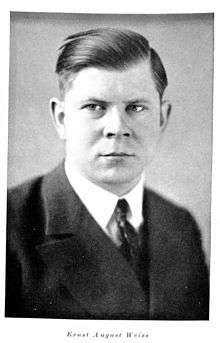Ernst August Weiß
Ernst August Weiß[2] (or Weiss;[1] 5 May 1900 in Strasbourg – 9 February 1942 in a Nazi field hospital near Lake Ilmen) was a German mathematician.

Early life and education
Since 1906, he attended the Lyceum in Metz, the Luther school and (1910–1912) Schiller gymnasium in Münster, and 1912–1917 the Mommsen-Gymnasium in Berlin, where he passed the Notabitur. He volunteered for the German military engineers in World War I, participated in the attrition warfare near Reims and Soissons and was captured 26 September 1918 during the tank battle near Cheppy by American soldiers.[1]:255 After his release in September 1919 he studied mathematics at Leibniz University Hannover and (1920–1924) Bonn University, where he obtained a Ph.D. in March 1924[1]:256 and a habilitation in May 1926.[1]:257 In August 1926, he married the physicist Eva Renate Bidder.[3]
Work in SA
Weiß joined an SA storm in Bonn in 1933, and got promoted up to an Obertruppführer. He directed the Bonn Studentenwerk.[1]:260 He created the Mathematical Work Camps ("Mathematische Arbeitslager") in Kronenburg "as a new form of mathematical university teaching and collaboration of professors and students",[1]:261 which took place 1—15 March 1934, 15—29 October 1934, 17 February–3 March 1935,[4] 23 February–7 March 1936,[5] and 17—31 October 1938.[6] Segal (1992) examined Weiß' camps from a pedagogical point of view, "as one example of how mathematics and Nazi ideology would interact".[7] Weiß was a permanent editor of the journal Deutsche Mathematik. A list of his publications is given in Blaschke (1942).[2]
Death
In 1941, Weiß took part in Operation Barbarossa as company commander of an engineer unit; during the Demyansk Pocket he was mortally wounded in close combat in Lukinn.[1]:263
Selected works
- Weiß, E. A. (1935). Einführung in die Liniengeometrie und Kinematik. Leipzig & Berlin: Teubner.[8]
- Weiß, E. A. (1939). Punktreihengeometrie. Leipzig & Berlin: Teubner.[9]
References
- Karl Strubecker(de) (July 1943). "Ernst August Weiss". Deutsche Mathematik. 7 (2/3): 254–298.
- Blaschke, W. (1942). "E. A. Weiß †" (PDF). Jahresbericht der Deutschen Mathematiker-Vereinigung. 52: 174–176.
- Record Archived 2018-04-04 at the Wayback Machine at University Heidelberg library
- Fritz Kubach(de) (January 1936). "Mathematische Arbeitslager". Deutsche Mathematik. 1 (1): 12–14.
- E.A. Weiß and Matth. Theis (July 1936). "Das vierte Mathematische Arbeitslager in Kronenburg (Eifel)". Deutsche Mathematik. 1 (3): 265–269.
- [No author] (May 1939). "Arbeiten aus dem 5. Mathematischen Arbeitslager Kronenburg". Deutsche Mathematik. 4 (2): 247–272.
- Sanford L. Segal (1992). "Ernst August Weiss: Mathematical Pedagogical Innovation in the Third Reich". In Sergei S. Demidov; Menso Folkerts; David E. Rowe; et al. (eds.). Amphora — Festschrift for Hans Wussing on the Occasion of his 65th Birthday. Basel: Springer. pp. 693–704. doi:10.1007/978-3-0348-8599-7. ISBN 978-3-0348-9696-2.
- Emch, Arnold (1936). "Review: Einführung in die Liniengeometrie und Kinematik" (PDF). Bull. Amer. Math. Soc. 42, Part 1 (9): 618–619. doi:10.1090/S0002-9904-1936-06367-6.
- Lewy, Hans (1940). "Review: Punktreihengeometrie by E. A. Weiss" (PDF). Bull. Amer. Math. Soc. 46 (3): 210–211. doi:10.1090/s0002-9904-1940-07168-x.